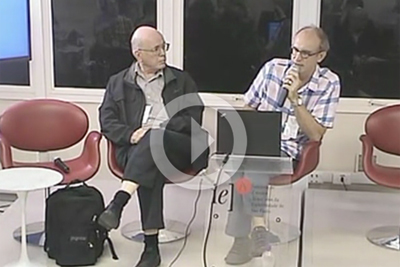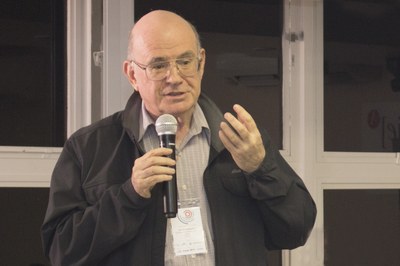The Attempts of Physics to Build Time
 The largest measured span of time is the 13.7 billion years since the Big Bang. The smallest is 10-18 second: one millionth of a millionth of a millionth of a second, measured in atomic excitation. From this time spectrum, physicists try to understand the experience and the flow of time.
The largest measured span of time is the 13.7 billion years since the Big Bang. The smallest is 10-18 second: one millionth of a millionth of a millionth of a second, measured in atomic excitation. From this time spectrum, physicists try to understand the experience and the flow of time.
In his lecture, Building Time in Physics – Attempts, on April 20 at the Intercontinental Academia, physicist Eliezer Rabinovici, from the Hebrew University of Jerusalem (HUJI), addressed some concepts that were discovered and developed to study the large and small scales of time, especially those used to explain the constitution of matter in unified theories and in string theory.
An expert on particle physics, Rabinovici was director of HUJI’s Institute for Advanced Study and creator of the proposal that resulted in the Intercontinental Academia.
Related materialRelated news The Relationship between Time and Astronomy in the Theory of Relativity |
Unified theory
“Although most of us measure from 1 to 2 meters, we boldly presume to explain the entire universe, from the smallest to the largest aspects. We want to explain and reduce everything to what is simplest. We believe we can put in one page all the equations that describe matter in the universe. That’s quite a feat.” Rabinovici’s comment seems to indicate that, at the very least, he sees with some reservation the possibility that physics will arrive at a unified theory combining all the forces that affect matter (electromagnetism, gravity, the weak interaction and strong interaction).
He said that in the 1920s scientists knew two interactions of matter, electromagnetism and gravity, which at low energies occur in four dimensions – three spatial ones, the fourth being time. “When energy was increased in particle accelerators, it was found that there is one basic interaction, gravity, and five dimensions. This was a great leap in our understanding of matter.”
According to Rabinovici, to evade the notion that an omnipotent equation may unify all the forces affecting matter (electromagnetism, gravity, strong interaction and weak interaction) and fully explain the constitution of matter, all we have to do is give it an infinite number of solutions. “In string theory, where strings (the components of matter) move in ten dimensions, this is what happens: we have an equation with, as far as we know, infinite solutions.”
Dualities
Rabinovici mentioned that the current work of physicists is impregnated with many mysterious things that seem dualities. “Initially, all known mathematical principles become ambiguous or seem to have the same theory. One of these concepts concerns the number of existing dimensions. The theory of five dimensions provides the same description as the theory of ten dimensions. And one of the dualities is the Big Crunch [the collapse of the universe due to contraction caused by gravity], which would be a terrible event for some and magnificent to others, with each explanation being as good as another.”
Relativity
Everyone now says everything is relative. This is not true, according to Rabinovici. “One of the worst representations of a theory is the fact that the Theory of Relativity is called Theory of Relativity. Einstein knew that the word was not appropriate. When asked five years later whether it might be better to change the name, he answered, ‘It’s too late’.”
According to Rabinovici, the Theory of Relativity is an attempt to isolate what is not relative, to become a theory about what every observer can agree on. “Time has relative aspects, but it is part of something that is not relative. Cause and effect relationships are not relative. The decay time of a particle (neutrons decay in 14 minutes) is not relative.”
 |
|---|
| Eliezer Rabinovici, from the Hebrew University of Jerusalem |
Symmetry
He said that laws of physics are roughly the same in both directions of the flow of time, but there is a small “breach of time” that can be measured in reverse symmetry. Even if the laws of physics are symmetric, why isn’t their manifestation symmetric? Why something destroyed cannot return to its previous state? To this question, Rabinovici said that that is not how things happen, because over a long course of time (“zillions of times the age of the Universe”) reconstitution might occur and that something could become quite similar to what it was.
Space-time
Rabinovici said that everyone learns at school or in popular readings that time merges with the space and only space-time exists, being impossible to think of each of them separately. “Time and space do indeed merge, but some things are invariant,” according to the physicist. “Space-time and gravity are closely linked and time and space are average quantities; however, they are not fundamental because they emerge from something else.”
Because humans are subject to extremely weak gravity (compared to other places in the universe, such as black holes), we have a relatively stable perception of time: “Because the universe expands, it has a radius. We can say where we are in terms of the size of that radius. That is our clock.”
